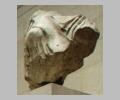
West pediment: Figure L (Athena-R) and Figure M (Poseidon-R)

West pediment: Figure H (Hermes-L) and Figure L (Athena-R)

West pediment: (L to R) Figures N ('Iris'), O ('Amphitrite...
| Collection: | London, British Museum and Athens, Acropolis Museum |
| Title: | Parthenon, West Pediment |
| Context: | From Athens, Acropolis |
| Findspot: | Found at Athens, Acropolis |
| Summary: | Athena's Strife with Poseidon |
| Sculptor: | Literary attestation to Pheidias |
| Material: | Marble |
| Sculpture Type: | Architectural |
| Category: | Statuary group |
| Placement: | West pediment |
| Style: | High Classical |
| Technique: | In-the-round |
| Original or Copy: | Original |
| Date: | 447 BC - 432 BC |
| Dimensions: | H. of Hermes 1.15 m |
| Scale: | Over life-size |
| Region: | Attica |
| Period: | High Classical |
Subject Description:
Athena's Strife with Poseidon (West pediment): The subject and setting are given by Pausanias (
The identity of the central figures is clear. Athena (L) moves left, Poseidon (M) right, away from the center of the pediment where some event has just occurred. Immediately on the left, Hermes (H) and Nike (G) driving her team rush to Athena. On the right, Iris (N) and Amphitrite (0) as Poseidon's charioteer and messenger rush toward him. Vases which depict the same subject and may reflect the pediment sometimes show an olive tree, sometimes a thunderbolt. An olive tree may have been added in bronze, though there is not much space in the center of the composition for an object of any size. (Marble fragments of olive sometimes attributed to the pediment are now usually thought Roman.) The tree would represent Athena's gift to Attica; Poseidon's gift was a salt spring. Simon has suggested that, rather than the moment of the contest itself, the aftermath is shown. Angered by his loss of the contest, Poseidon threatened to send a flood. Zeus intervened by throwing his thunderbolt. Simon has suggested the thunderbolt was represented in the center between Poseidon and Athena; a vase found at Pella now appears to support her conjecture.
As in the east pediment, it is the subsidiary figures to either side whose identities are much debated. The possibilities include personifications, heroes or gods. Modern scholarly opinion appears to be leaning in the direction of heroes, primarily because the subject is specifically Attic. The figures are essentially spectators or witnesses of the struggle in process. Since the prize is the land of Attica, it is appropriate that those most concerned be on hand. Furthermore, the number of children in family groups suggests the representation of linked generations.
For the left side a widely accepted interpretation sees Kekrops, a legendary king of Attica, as the older man (B) sitting on a rock beside a snake. Beside him is surely one of his daughters, probably the oldest, Aglauros (C). The other two young women (D and F) presumably represent the other two daughters, Pandrosos and Herse. The young man (E) is probably either his son Erysichthon or his adopted son Erichthonios, the foster child of Athena by Hephaistos and later king of Athens. In the corner (A and A*) are either personifications in the manner of the Olympia pediments — the river god Ilissos or Kephisos is usually suggested — or yet more ancient Attic hero kings, such as Aktaios, or Boutes and Erechtheus.
On the right hand side of the pediment three female figures are often correspondingly identified as the daughters of Erechtheus. The figure seated close to Amphitrite with billowy drapery and two children (P,Q,R) is suggested as Oreithyia, wife of Boreas and mother of twins. The other females (T,U) would be Kreousa and Prokris. The young male (S) is sometimes identified as Ion, although strong evidence is lacking. The aforementioned identifications make these figures Athenians. A recent proposal instead views the figures on the right hand side of the pediment as Eleusinians, descendants of Poseidon. Such an identification suggests the contest between Athena and Poseidon was seen as a metaphor for the struggle between Athens and Eleusis. The two subjects are known to be related on vases and in literature. According to this theory, the figures named above are identified as Metaneira, wife of the legendary king Keleos, and his children. The adopted son Triptolemos would parallel Erichthonios on the opposite half. Near the corner Eumolpos (V), son of Poseidon, priest/king of Eleusis and founder of the Eleusinian Mysteries, had previously been proposed and fits with the new theory as well. The figure next to him would be his mother Chione (W). An alternate interpretation of her is as Kallirhoe, an Athenian spr
Condition: Fragmentary
Condition Description: Single fragment preserving upper torso of Athena and another large piece preserving entire torso plus upper thighs of Hermes. Part of head of Athena is in Acropolis Museum. Surfaces chipped and abraded.
Material Description: Pentelic Marble
Associated Building: Athens, Parthenon
Sources Used:

